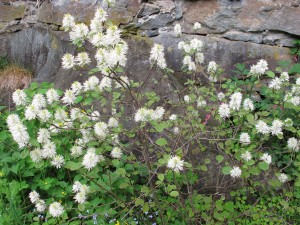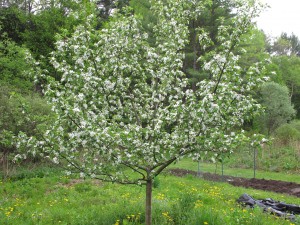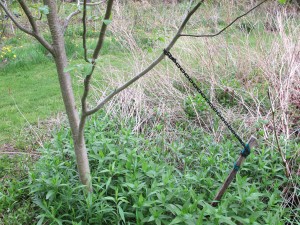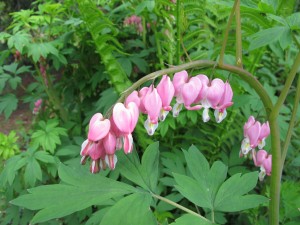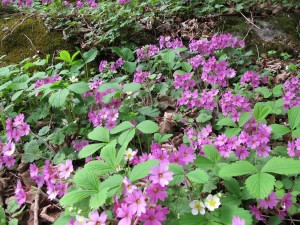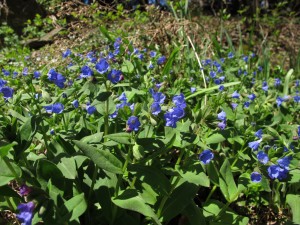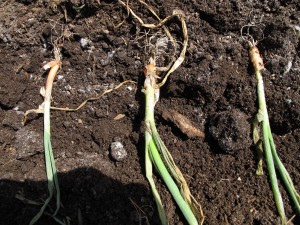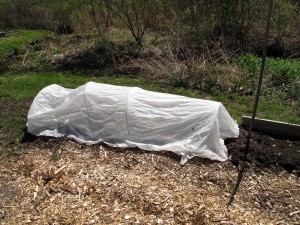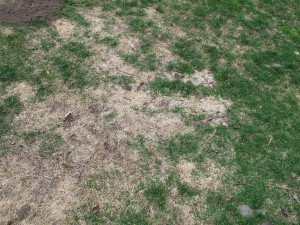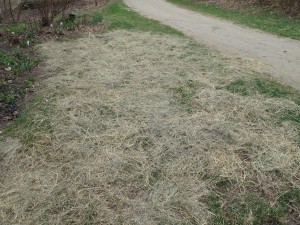Growing Some Lesser Known Vegetables
This year as you plan your garden, why not choose some lesser known veggies to see how they do for you? You might just be surprised how easy it is to grow kohlrabi or rutabagas – and how tasty they are. I grow those, and several other kinds of vegetables that you might not have tried. Most are not terribly hard to grow. You could be the first on your block to grow artichokes!
Let’s start with sweet potatoes. Most New England gardeners don’t generally grow this vegetable, thinking that it’s a southern crop. It is, but you can grow it. The trick is to grow it under black plastic, which increases the heat. It needs good rich soil, liberally amended with compost or aged cow manure. Start plants from little plants called slips, available from catalogs such as Johnny’s Selected Seeds (www.johnnyseeds.com).
Adequate moisture is key for growing sweet potatoes. Even if you leave an opening in the plastic for the plant, rain water probably won’t soak the soil enough. Run a section of soaker hose under the plastic and give it some water any time the soil seems dry. Soaker hoses are available at garden centers and are basically special hoses that ooze water very slowly, soaking the soil.
Rutabagas, like Rodney Dangerfield, don’t get the respect they deserve. They are easy to grow, rarely bothered by pests or diseases, and can substitute for potatoes in the kitchen. They look a bit like turnips (which do have a strong flavor) but rutabagas are mild. I find they are great in stews- they don’t get mushy the way potatoes do when you re-heat the stew several times.
Plant rutabagas by seed in mid-June about 2 inches apart and thin to 6 inches apart for maximum production. Rutabagas can get big –a pound each or more, but do not get tough or less tasty even when they get big. They grow best in soil that is near neutral on the pH scale and is rich in compost.
As far as I am concerned, growing celery is best left to the professionals. When I’ve tried growing it, the slugs loved it and the stalks were dry and stringy. But you can have that same celery flavor in your soups, stuffing and stews by growing celeriac, also known as celery root. I start celeriac by seed in the house in late March or early April, but some better garden centers will offer plants already started. Celeriac loves moisture, so add compost to the soil to hold water, and water during dry times. Plant about 6 inches apart.
Salsify and scorzonera are long, thin root crops with a somewhat nutty flavor. They need deep, loose soil as they can grow 8-12 inches long. But each is only an inch or less in diameter, so they don’t produce much food per plant (compared to carrots or rutabagas, for example). Plant directly in the garden, and wait. They are slow growing, so plant early and harvest late in the fall. Great in turkey stuffing.
Artichokes are beautiful plants that look good in a flower garden, too. In California they are perennials, producing year after year in deep black soil rich with moisture. I have started them from seed, but one must start them early in March for best results. But some garden centers sell them in small pots, so most years I buy them.
Allow a 2-foot by 2-foot space or more for each artichoke plant. You will get one artichoke (which is really a flower bud) at the top of the plant, then side shoots with smaller artichokes after that, up to 5 more. None will be as big as the grocery store version. Be sure to pick them before they turn dry and open up.
My favorite of the odd ducks of the vegetable world is kohlrabi, which looks a little like a space alien: a round fat “root crop” that sits in the soil surface and has stems popping out of it like arms –and then leaves, of course. The vegetable is almost perfectly round and is actually a thickened stem. It comes in purple and green varieties. Eaten fresh in salads it tastes something like a cucumber crossed with a radish. But they are good in stir fries or stews, too.
Plant kohlrabi seeds directly in the garden about 3 inches apart and thin to 6 inches. It is in the cabbage family (Brassica) and grows fast, ready for harvest in as little as 8 weeks. Last year I grew a variety called “Kossak’ that is an 80-day variety, but it gets to be huge (8” or more) and stores well – Johnny’s Selected Seeds, the developer of the seed – says it will store for 4 months! It needs plenty of moisture, and like most veggies, plenty of compost in the soil.
Of the salad/cooking greens, think of trying orach. Seeds are hard to find – Baker Creek Heirloom Seeds is the only place I’ve found that has them (www.rareseeds.com). This is a gorgeous purple-leafed plant that gets to be three feet tall, and is in the goosefoot family which includes many varieties of weeds – but also spinach, beets and quinoa. If you let a few plants flower and go to seed, you will always have some volunteer plants in the garden, year after year. It has no special growing needs; it’s almost a weed, after all.
Gardening is supposed to be fun. For me that means trying more than the usual veggies. So this year, get adventurous. Try kohlrabi, rutabagas or even an artichoke! You’ll be glad you did.
Henry Homeyer’s Web site is www.Gardening-Guy.com. You may reach him at henry.homeyer@comcast.net.
Selecting and Training Flowering Trees
This has been a great year for flowering trees and shrubs. My Merrill magnolia had many hundreds of white blossoms in late April.
The crabapples everywhere put on a spectacular display this year. My fothergilla (a shrub with great fall leaf color) is in bloom now with its tidy white bottle-brush flowers. My ‘Olga Mezitt’ rhododendron (one of the parents of the popular PJM rhodie) is looking great and my wild azaleas are getting ready to bloom. And now the lilacs are blooming for me and I am overwhelmed with the large purple, blue, white and pink panicles (clusters of flowers). Spring has definitely sprung.
All these blooms this year will certainly encourage many gardeners to buy trees and shrubs and plant them. That’s a fine idea, but if you plant now, please remember that you must keep watering them all summer if we don’t get an inch or more of rain per week. When August comes around it will be easy to have your new tree dehydrate if you get lazy or forgetful.
New trees and shrubs need a year or more to grow roots sufficient for their needs if we get hot, dry weather. So if you are forgetful or will be doing lots of traveling, you might want to hold off on planting a new tree until fall, which is also a good time for planting. Fall is cooler and more likely to be rainy.
I like to buy flowering trees and shrubs when they’re in bloom. That allows me to see the color and check out the fragrance. But there is more than just the flowers to consider when selecting a good crabapple or magnolia. Let’s start with size and price. Bigger
is not necessarily better. If you are on life support and don’t expect to be around in 5 years, sure, buy the biggest tree you can afford. But be aware that a bigger tree is not only more expensive – it is also harder to plant and takes more water and care. A bigger tree may have a smaller proportion of its root system intact after being dug up and put in a pot than a small tree. I like to buy smaller specimens and then train them to be a nice shape. That’s harder to do on a larger tree.
I recently visited a nice new nursery run by Henderson’s Tree Service on Rte 14 in Hartford, Vermont. There I chatted with my friend Sylvia Provost who is co-owner of the business. I asked Sylvia what she would look for if purchasing a crabapple for herself. Without a moment’s hesitation she responded. “Structure,” she said.
What Sylvia was talking about is the shape of the tree and the placement of the branches. Fruit trees produce best on branches that leave the trunk at a right angle or are aiming just slightly upward. Branches that shoot straight up are not usually good fruit and blossom producers.
And although Sylvia noted that you can train a tree to be the shape you want, it is easier to start with something that is closer to your ideal before you start training. So, for example, Sylvia said that if you have a swimming pool some distance from your patio, you should choose a tree that has an open format, one that you can see through – and see what is happening at the pool. Conversely, if you have nosy neighbors and want to screen their view of your patio, you might select a tree that has a full, dense arrangement of branches.
Generally, pruning a tree should begin in the second year of its life at your home. I often see apple and crabapple trees that have very low branches. I like to prune off those low branches to make it easy to mow around, and to have a nicer look. And if two branches are both striving to be the “leader” or the dominant, tallest stem, I remove one. And although most books say you should prune fruit trees in March or April, you can safely make a few judicious cuts now to train your tree.
You may train branches to grow at different angles by weighing them down – if you do so soon. This is an activity for spring, starting before the new layer of cambium growth has occurred. You can drive a stake into the ground and tie a branch to it for the next 2 months. A branch the diameter of a finger can weighed down by hanging a plastic pop bottle on it, then filling it with water until it bends to the correct angle.
Chris Wilson of the EC Brown Nursery in Thetford, Vermont suggested that when buying a tree, look at leaf color – leaves should be green, not tinged with yellow. He also suggested making sure the tree has branches on all sides, and that the bark has not been damaged.
So if you’ve delighted in the flowers on trees in your neighborhood this year, go get one or more. Study several specimens to find the best one. And just remember to water all summer long!
Henry Homeyer is a gardener and garden designer living in Cornish flat, NH. His Web site is www.Gardening-Guy.com.
Spring Flowers
Like most gardeners, I rejoice in spring. New leaves on trees have a special hue; the grass is finally green; flowers of every persuasion are in bloom. The air is warm, the black flies haven’t arrived, life is good. So we trundle off to the garden center and buy flowers and plant them. Here are some flowers I am enjoying in May, including a few you might not have in your garden.
I know most of you don’t like Latin names of flowers, but they are useful for precisely naming flowers, and for showing relationships. The scientific genus Dicentra is in its full glory now: D. spectabalis, D. exemia, D. cucularia are three species in bloom for me.
The first one (D. spectabalis ) is spectacular, as its Latin name indicates. I have some plants that stand up to 3 feet tall and wide, and it can have dozens of flower stems at once. You probably call it bleeding heart – though some call it “a living Valentine”, which is appropriate since the strands of pink flowers are shaped like cut-out hearts with little appendages hanging down, perhaps drops of blood from a broken heart. It also comes in a pure white variety, a sub-species with the epithet ‘alba’ appended to its name.
Bleeding hearts will grow in full sun, but do better in part sun or dappled shade and rich, lightly moist soil. Full afternoon sun will make them run through the bloom cycle more quickly and the foliage to turn yellow well before autumn.
Fringed bleeding heart (D. exemia) is shorter and less showy. It is a shade plant that will bloom on and off all summer, which is unusual for a perennial. The flowers come in shades of pink to reddish, and there is also a white variety. Although it is often called wild bleeding heart, I have only seen it in the woods a few times. Its foliage is very nice – it is highly incised and frilly.
The last of the three, D. cucularia, is commonly known as Dutchman’s breeches for the white flowers which resemble pants hanging on a clothesline. It is a true wildflower, but is sold at a few good nurseries. It is what is called a spring ephemeral: it comes up, blooms, and the foliage disappears after a few weeks. I pronounce its species name cuckoo-laria, which to me is a humorous name for a flower. “Cuckoo, cuckoo” I call out to it when I see it blooming. (See, aren’t you liking Latin better? It can be fun to use.) Mine grows in the shade of an old apple tree in damp, rich black soil.
If you have a mature apple tree, it is a great place for growing primroses. In mid-May I have several species growing under mine, including a fabulous magenta-colored one that has no common name, so you will have to ask for it by its Latin name, Primula kisoana. Or you can call it the kissing primrose, I suppose, since the species name starts off with “kiss”. (Kiss-o-ana). But at the garden center they will not know it by that name, only the Latin. I got mine at Cider Hill Gardens in Windsor, VT.
Primroses are low plants that grow in clumps that I have in all colors except blue. Most do best in shade or part shade, and many will grow in dry shade – though moist soil is better for most. Coming along soon I will have the candelabra primroses (Primula japonica), which indicates they were introduced from Japan). These are the tallest of my primroses, reaching up to 18 inches or so. They have three tiers of blossoms sticking out off a tall straight stem sort of like the spokes of a wagon wheel, and come in at least 3 colors – white, pink, deep red.
For the past 6 weeks or more I’ve had various colors of lungwort (Pulmonaria longifolia) blooming. Lungwort is a dreadful name for a lovely flower, so I call it by its Latin genus, Pulmonaria (pronounced Pull-mon-aria) . It starts very early and blooms for a long time; it comes in a variety of colors: blue, peach, pink and combinations of those. It spreads by root, filling in dark, shady places that many flowers would eschew. It does fine in crummy dry soil.
You know the common bulb plants: daffodils, tulips, crocus. If you’ve planned well – selecting early, mid- and late-season varieties – you have examples of those blooming much of the spring. But do you have summer (or giant) snowflake (Leucojum aestivum)? It is wonderful! I’ve had a clump for 15 years or more, and it just gets bigger and better every year. It reminds me of snowdrops on steroids. White nodding blossoms on tall green stems and lots of foliage. Mine are 18-24 inches tall, even though my reference text on bulbs (Taylor’s Guide to Bulbs) says it should be only 9-12 inches tall.
One last thought: take pictures of your flowers on a weekly basis. These will help you do planning next winter when you are trying to see what times of the year need more color. Your digital camera will keep track of the dates of blooming, too.
Henry Homeyer is a garden designer and public speaker on gardening. Contact him at henry.homeyer@comcast.net, PO Box 364 , Cornish Flat, NH 03746 or 603-543-1307.
Getting Started in the Vegetable Garden
After a few hot spring days many of us are more than ready to plant vegetables in the garden. It’s important, however, not to jump the gun. There are things you can plant now, but others still have to wait – tomatoes, peppers, eggplants, cukes and squashes, among others. My garden will surely see frost again, and the ground is not as warm as many plants need to do their best.
I have planted my peas, and I would say it’s safe for anyone in New England, even the cold spots, to plant them now. That said, let me warn that pea seeds can rot if planted in cold, wet soil. I have a relatively wet vegetable garden because it is near a stream and the water table is high. To fix that problem I grow my veggies in wide raised beds.
Most of my beds are just mounds of soil that are six inches taller than the walkways and about 30-36 inches wide. When making the beds I loosened the soil, then raked soil from walkways into the beds, which raised them up. I also add wheelbarrows of compost each year and work it into the top few inches of my raised beds – making them even taller. Now they drain well, which is important in spring or during long periods of rainy weather.
I have planted my onions, too. Some years I plant onions by seed indoors in early March. Other years I buy onion plants. These are always bigger and fatter plants than the onions I start from seed. Maybe they start growing them in January – but I don’t want to have to baby plants along for such a long time.
Most gardeners buy onion sets, which look like little bulbs, though I rarely do so now. These are tiny onions that are already a year old – they’ve been grown so close together that they never developed any size and are used to start new plants. They certainly do work, and are much less expensive than buying onion plants. But I feel they are less vigorous than the plants.
What else have I planted outdoors by seed? Spinach, lettuce, carrots, kohlrabi and beets. Spinach is the hardiest of those – frost is not generally a problem, even for young plants. The others are somewhat frost hardy but can benefit by some protection if the weather is forecast to drop into the mid- to low-twenties. Row cover or Reemay is a spun synthetic fabric that works well to provide a little frost protection.
There are different thicknesses of row cover available, including one called the GardenQuilt Cover, which claims frost protection to 24 degrees F. When I use that, I keep it on only at night – light passes through it, but it reduces the strength of the light considerably. Others, the thinner ones, only provide a degree or two of protection, but can stay on all the time, keeping insects like flea beetles from getting to your plants.
Young plants are much less frost hardy than older plants. Kale, for example, will survive very cold temperatures when mature, but can be damaged when young by moderate frost. I have harvested kale in December when covered by snow. I start my kale plants indoors in April and then plant them outside in mid-to late- May.
Any plant that has been started indoors needs to be hardened off before going into the ground. This is also true for plants purchased from garden centers. You should ask when you buy seedlings of annual flowers and vegetables if they have been hardened off. If they are on display on tables in the sun, they probably will be fine. But things grown indoors or in greenhouses have tender leaves that can literally get sunburned or wind burned.
I harden off my seedlings over a 5 to 7 day period. I start by carrying flats of seedlings outdoors and giving them morning sun in a place where the house blocks the wind. Then the go to a spot where they get a couple of hours of afternoon sun for a couple of days. Finally they get all day sun and are ready after a day to go in the ground.
Watering is key for small plants. They don’t have a big root system yet, so they can dry out quickly. I check seedlings growing in pots or 6-packs at least twice a day (when outdoors, or once if indoors) to see if they need watering. Bigger seedlings, those that have been growing for several weeks, get a little dilute fish or seaweed fertilizer as they have used up the nutrition found in potting mix (which is relatively void of minerals).
Once in the ground seedlings still need daily watering. I like to use a watering can as it is gentler than a hose. I water seeds that have not germinated daily (or check to see if they need any), too.
Spring is the time when the garden makes its most urgent demands. Fortunately, most of us are eager to spend time outside now, too. Enjoy!
In addition to being an avid home gardener, Henry Homeyer is a gardening consultant and a specialist in fruit tree pruning. Contact him at henry.homeyer@comcast.net. His Web site is www.Gardening-Guy.com.




